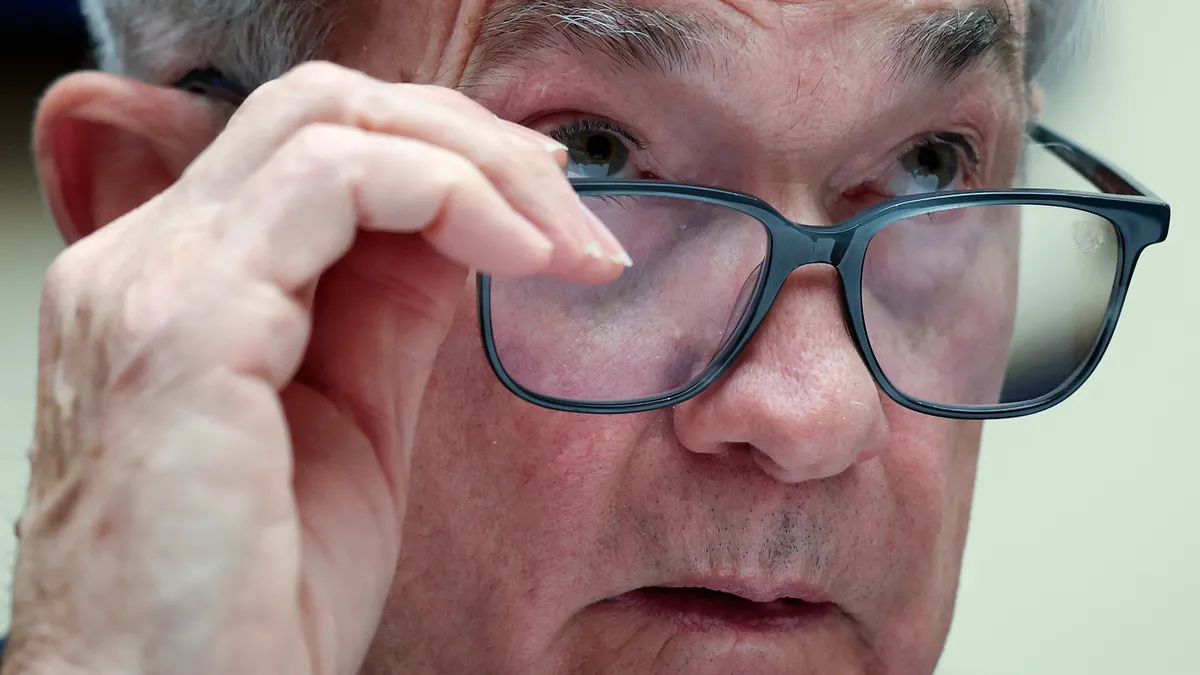It would be easy to look at the run time of Federal Reserve Chair Jerome Powell’s speech Friday at the Kansas City Fed’s annual policy forum in Jackson Hole, Wyoming, and wonder how the substance of it could possibly outweigh its preceding anticipation.
However, amid the speech’s eight minutes, Banking Dive found three key takeaways:
1. A hint toward another 75-basis-point interest rate boost (or higher?)
Powell noted that the Federal Open Market Committee had raised interest rates by three-quarters of a percentage point in each of its last two meetings. Whether the panel will do the same at its next meeting in September is unclear, Powell indicated, saying the decision “will depend on the totality of the incoming data and the evolving outlook.”
Key quote: “At some point, as the stance of monetary policy tightens further, it likely will become appropriate to slow the pace of increases.”
Observers may have expected Powell’s next words to be: But that time isn’t now.
Rather, he said, “Restoring price stability will likely require maintaining a restrictive policy stance for some time. The historical record cautions strongly against prematurely loosening policy.”
The interest rate now stands at a range between 2.25% and 2.5%. Fed officials in June projected rates to rise to a median estimate of 3.4% by the end of this year and 3.8% by December 2023, according to Bloomberg.
Powell also referenced a dip in inflation in July — to 8.5%, from 9.1% in June — but emphasized caution.
“While the lower inflation readings for July are welcome, a single month's improvement falls far short of what the committee will need to see before we are confident that inflation is moving down,” he said. “Estimates of longer-run neutral are not a place to stop or pause.”
2. Pain management, not pain avoidance.
The Fed has a two-pronged mission, but Powell appeared less worried about maximum employment Friday. To that, he characterized the labor market as “particularly strong but … clearly out of balance,” with demand “sufficiently” outpacing supply.
Rather, the other prong — price stability (and its return) — served as a cornerstone of the speech, noting the FOMC’s “overarching focus” is to return inflation to the panel’s 2% goal.
“Without price stability, the economy does not work for anyone. In particular, without price stability, we will not achieve a sustained period of strong labor market conditions that benefit all,” Powell said. “The burdens of high inflation fall heaviest on those who are least able to bear them.”
The gist, he said, is we have to accept “a sustained period of below-trend growth” to reduce inflation — prioritizing long-term economic health over the lure of short-term gains. But that doesn’t mean it won’t hurt. Rather, it will hurt less but sooner.
Key quote: “While higher interest rates, slower growth, and softer labor market conditions will bring down inflation, they will also bring some pain to households and businesses. These are the unfortunate costs of reducing inflation. But a failure to restore price stability would mean far greater pain.”
Powell characterized the Fed’s mission to deliver price stability as “unconditional.”
“The Fed's tools work principally on aggregate demand,” he said. “None of this diminishes the Federal Reserve's responsibility to carry out our assigned task of achieving price stability.”
3. The influence of expectation.
Powell quoted not one but two past Fed chairs in the latter half of Friday’s speech, first referencing a 1979 statement Paul Volcker made to lawmakers: "Inflation feeds in part on itself, so part of the job of returning to a more stable and more productive economy must be to break the grip of inflationary expectations.”
Namely, if people expect inflation to remain low and stable, it likely will “absent major shocks,” Powell said, adding, “The same is true of expectations of high and volatile inflation.”
Key quote: “Longer-term inflation expectations appear to remain well anchored … But that is not grounds for complacency, with inflation having run well above our goal for some time.”
Households and businesses must pay close attention to inflation when it is persistently high — and incorporate it into their economic decisions, Powell said.
But prices are truly stable, Powell inferred, invoking 1989 testimony from former Fed Chair Alan Greenspan, when “expected changes in the average price level are small enough and gradual enough that they do not materially enter business and household financial decisions."
















